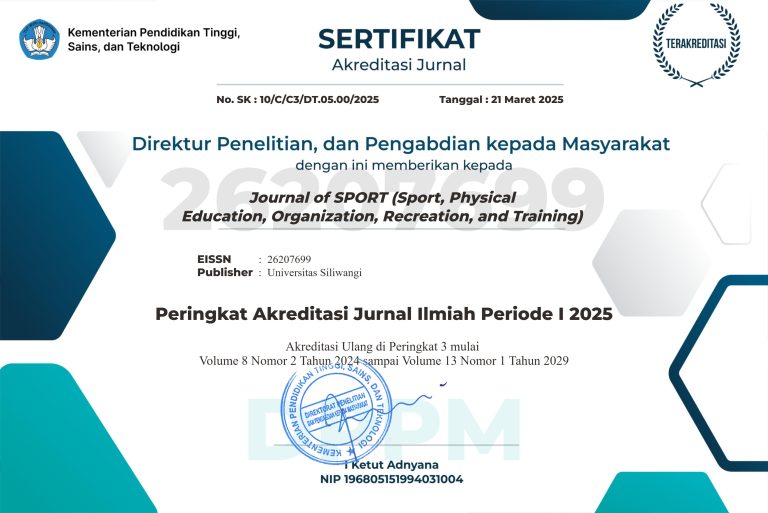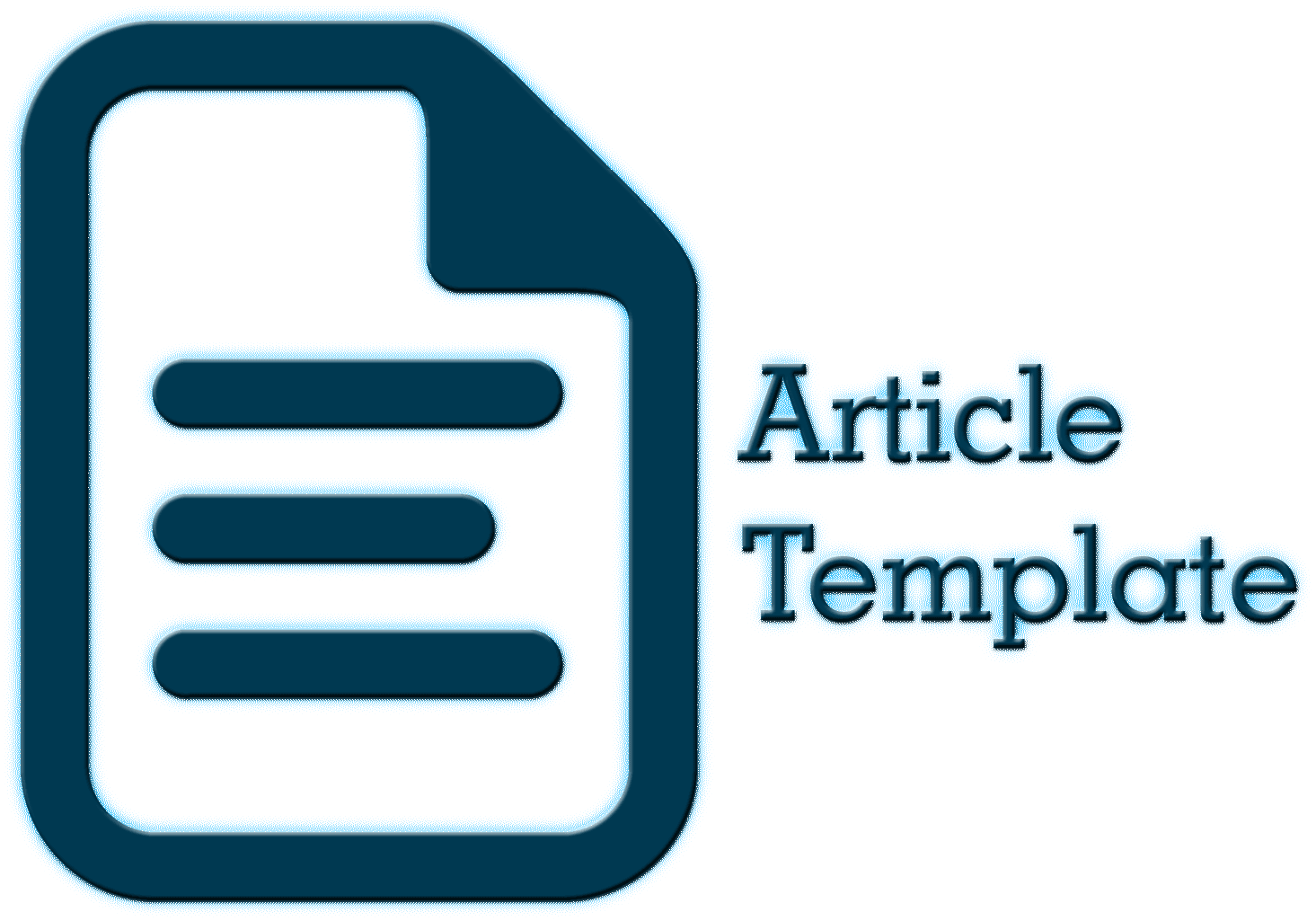Pengaruh Metode Pembelajaran Eksplisit Dan Implisit Berdasarkan Kapasitas Memori Kerja (Working Memory) terhadap Penguasaan Pasing Bawah dalam Permainan Bola Voli (Studi Eksperimen di SMP Negeri 1 Malausma Kabupaten Majalengka)
Abstrak
Tujuan penelitian ini yaitu untuk menguji : (1) perbedaan pengaruh metode pembelajaran eksplisit dan implisit berdasarkan pada kapasitas working memory terhadap penguasaan keterampilan pasing bawah; (2) perbedaan pengaruh kapasitas working memory rendah dan tinggi pada pembelajaran menggunakan metode eksplisit dan implisit terhadap penguasaan keterampilan pasing bawah; dan (3) interaksi antara metode pembelajaran dan kapasitas working memory terhadap penguasaan keterampilan pasing bawah dalam permainan bola voli.
Metode penelitian yang digunakan yaitu metode eksperimen dengan desain factorial. Penelitian ini dilakukan pada peserta didik di SMP Negeri 1 Malausma dengan rata-rata usia 13 tahun dan jumlah sampel 48 orang terbagi dalam 2 kelompok eksperimen dengan perlakuan metode pembelajaran eksplisit dan implisit. Peserta didik mengikuti program pembelajaran adalah sampel sukarela, pemula dalam permainan bola voli, tidak memiliki keterbatasan pada penglihatan, pendengaran. Hasil pengukuran diperoleh skor rata-rata sebesar 9.30 atau sekitar 27% peserta didik memiliki kapasitas working memory pada kelompok dengan perlakuan metode pembelajaran eksplisit dan implisit.
Hasil penelitian ini menunjukan yaitu : (1) terdapat perbedaan pengaruh metode pembelajaran eksplisit dan implisit berdasarkan kapasitas working memory terhadap penguasaan keterampilan pasing bawah; (2) tidak terdapat perbedaan pengaruh kapasitas working memory rendah dan tinggi pada pembelajaran dengan menggunakan metode eksplisit dan implisit terhadap penguasaan keterampilan pasing bawah; dan (3) tidak ada interaksi antara metode pembelajaran dan kapasitas working memory terhadap penguasaan keterampilan pasing bawah dalam permainan bola voli.
Kata kunci : pembelajaran, metode eksplisit, implisit, working memory dan pasing bawah.
Teks Lengkap:
PDFReferensi
Referensi Utama (Jurnal):
Abswoudea, F., Buszardb T., Kampd, J., & Steenbergena B. (2020). The role of working memory capacity in implicit and explicit sequence learning of children: Differentiating movement speed and accuracy. Human Movement Science, 69.
Aksović, N., Bjelica, B., Jovanović, L., Ljubica, M., & Zelenovic, M. (2021). Teaching methods in teaching physical education. Italian Journal of Sports Rehabilitation and Posturology, 10(26), 2684 – 2694. https://oaji.net/articles/2021/1587-1633703766.pdf
Bitan, T., Tremblay, L., & Nil, L. De. (2023). Explicit benefits : Motor sequence acquisition and short-term retention in adults who do and do not stutter. 75(May 2022). https://doi.org/10.1016/j.jfludis.2023.105959
Bartlett, J., Smith, L., Davis, K., & Peel, J. (1991): Development of a Valid Volleyball Skills Test Battery, Journal of Physical Education, Recreation & Dance, http://dx.doi.org/10.1080/07303084.1991.10606554
Bobrownicki, R., MacPherson, A. C., Coleman, S. G., Collins, D., & Sproule, J. (2015). Re-examining the effects of verbal instructional type on early stage motor learning. Human movement science, 44, 168-181.
Bobrownicki, R., MacPherson, A. C., Collins, D., & Sproule, J. (2019). The acute effects of analogy and explicit instruction on movement and performance. Psychology of Sport and Exercise, 44, 17-25.
Buszard, T., & Masters, R. S. W. (2018). Adapting, correcting and sequencing movements: does working-memory capacity play a role? International Review of Sport and Exercise Psychology, 11(1), 258–278. https://doi.org/10.1080/1750984X.2017.1323940
Capio, C. M., Poolton, J. M., Sit, C. H. P., Holmstrom, M., & Masters, R. S. W. (2013). Reducing errors benefits the field-based learning of a fundamental movement skill in children. Scandinavian Journal of Medicine & Science in Sports, 23(2), 181–188. https://doi.org/10.1111/j. 1600-0838.2011.01368.x Chatzopoulos, D., Foka, E., Doganis,
Cerciello, S., Corona, K., Fiquet, C., & Neyret, P. (2022). Volleyball. Epidemiology of Injuries in Sports, 143–147. https://doi.org/10.1007/978-3-662-64532-1_22
Cockcroft, K. (2015). The role of working memory in childhood education: Five questions and answers. South African Journal of Early Children Education, 5(1), 1-21.
Forey, G., & Cheung, L. M. E. (2019). The benefits of explicit teaching of language for curriculum learning in the physical education classroom. English for Specific Purposes, 54, 91–109. https://doi.org/10.1016/j.esp.2019.01.001
Henrik G. (2022). Implicit versus explicit learning a novel skill for high school students and young gymnastics athletes. 1–24. https://nordopen.nord.no/nord-xmlui/bitstream/handle/11250/3041013/Henrik Borge Garnaas.pdf?sequence=1&isAllowed=y
Jongbloed-Pereboom, M., Nijhuis-van der Sanden, M. W. G., & Steenbergen, B. (2019). Explicit and implicit motor sequence learning in children and adults; the role of age and visual working memory. Human Movement Science, 64(December 2018), 1–11. https://doi.org/10.1016/j.humov.2018.12.007
Jaroslawska, A. J., Gathercole, S. E., Logie, M. R., & Holmes, J. (2016). Following instructions in a virtual school: Does working memory play a role? Memory & Cognition, 44(4), 580–589. https://doi.org/10.3758/s13421-015-0579-2.
Jung, H., & Choi, E. (2016). The importance of indirect teaching behaviour and its educational effects in physical education. Physical Education and Sport Pedagogy, 21(2), 121–136. https://doi.org/10.1080/17408989.2014.923990
Kal, E., Prosée, R., Winters, M., & Van Der Kamp, J. (2018). Does implicit motor learning lead to greater automatization of motor skills compared to explicit motor learning? A systematic review. PLoS ONE, 13(9), 1–25. https://doi.org/10.1371/journal.pone.0203591
Kalra, P. B., Gabrieli, J. D. E., & Finn, A. S. (2019). Evidence of stable individual differences in implicit learning. Cognition, 190(July 2018), 199–211. https://doi.org/10.1016/j.cognition.2019.05.007
Kim, I. (2016). Exploring changes to a teacher’s teaching practices and student learning through a volleyball content knowledge workshop. European Physical Education Review, 22(2), 225–242. https://doi.org/10.1177/1356336X15599009
Kleynen, M, Braun S. M, Bleijlevens M. H., Lexis M. A., Rasquin S. M., & Halfens J., et al (2014). Using a Delphi technique to seek consensus regarding definitions, descriptions and classification of terms related to implicit and explicit forms of motor learning. PLoS One, 9(6).
Kok, M., Kal, E., van Doodewaard, C., Savelsbergh, G., & van der Kamp, J. (2021). Tailoring explicit and implicit instruction methods to the verbal working memory capacity of students with special needs can benefit motor learning outcomes in physical education. Learning and Individual Differences, 89(May 2020), 102019. https://doi.org/10.1016/j.lindif.2021.102019
Kok, M., Nuij, J., Kal, E., & Kamp, J. Van Der. (2022). Human Movement Science Individual differences in working memory capacity and conscious processing do not explain explicit and implicit learning outcomes in physical education. Human Movement Science, 86(June), 103003. https://doi.org/10.1016/j.humov.2022.103003
Lola, A. C., & Tzetzis, G. (2020). Analogy versus explicit and implicit learning of a volleyball skill for novices: The effect on motor performance and self-efficacy. Journal of Physical Education and Sport, 20(5), 2478–2486. https://doi.org/10.7752/jpes.2020.05339
Lopes, M. C., Magalhães, R. T., Diniz, L. B. F., Moreira, J. P. A., & Albuquerque, M. R. (2016). A influência da habilidade técnica na tomada de decisão de jogadores iniciantes de voleibol. Revista Brasileira de Cineantropometria e Desempenho Humano, 18(3), 362–370. https://doi.org/10.5007/1980-0037.2016v18n3p362
MacPhail, A., Tannehill, D., Leirhaug, P. E., & Borghouts, L. (2021). Promoting instructional alignment in physical education teacher education. Physical Education and Sport Pedagogy, 0(0), 1–12. https://doi.org/10.1080/17408989.2021.1958177
McKay, E. (2002). Cognitive Skill Acquisition Through a Meta-Knowledge Processing Model, Interactive Learning Environments, 10(3), 263-291.
Masters, R. S. W. (1992). Knowledge, nerves and know-how: The role of explicit versus implicit knowledge in the breakdown of a complex motor skill under pressure. British Journal of Psychology, 83, 343-358.
Masters, R. S. W., Poolton, J. M., Maxwell, J. P., & Raab, M. (2008b). Implicit motor learning and complex decision making in time constrained environments. Journal of Motor Behavior, 40, 71–79.
Maxwell, J. P., Masters, R. S. W., & Eves, F. F. (2003). The role of working memory in motor learning and performance. Consciousness and Cognition, 12, 376–402.
Neill, J. T. (2008). Enhancing life effectiveness: The impacts of outdoor education programs. Education, 1(May), 1–452.
Nesbitt, D., Fisher, J., & Stodden, D. F. (2021). Appropriate Instructional Practice in Physical Education: A Systematic Review of Literature From 2000 to 2020. Research Quarterly for Exercise and Sport, 92(2), 235–247. https://doi.org/10.1080/02701367.2020.1864262
Undang-undang Nomor 20 Tahun 2003tentang Sistem Pendidikan Nasional (Sisdiknas), pasa 1
Poolton, J. M., Masters, R. S. W., & Maxwell, J. P. (2006). The influence of analogy learning on decisionmaking in table tennis: Evidence from behavioral data. Psychology of Sport and Exercise, 7, 677–688.
Poolton, J. M., Masters, R. S. W., & Maxwell, J. P. (2007). Passing thoughts on the evolutionary stability of implicit motor behavior: Performance retention under physiological fatigue. Consciousness and Cognition, 16, 456–468.
Slater, T., & Butler, J. I. (2015). Examining connections between the physical and the mental in education: A linguistic analysis of PE teaching and learning. Linguistics and Education, 30, 12-25.
Tzetzis, G., & Lola, A. C. (2015). The effect of analogy, implicit, and explicit learning on anticipation in volleyball serving. International Journal of Sport Psychology, 46, 152–166.
Tzetzis, G., & Lola, C. A. (2010). The role of implicit, explicit instruction and their combination in learning anticipation skill, under normal and stress conditions. International Journal of Sport Sciences and Physical Education, 1, 54-59
Turner dan Ridsdale (2004). the digit span test.
Votsis, E., Tzetzis, G., Hatzitaki, V., & Grouios, G. (2009). The effect of implicit and explicit methods in acquisition of anticipation still in low and high complexity situations. International Journal of Sport Psychology, 40(3), 374-391
van Abswoude, F., Mombarg, R., de Groot, W., Spruijtenburg, G. E., & Steenbergen, B. (2021). Implicit motor learning in primary school children: A systematic review. Journal of Sports Sciences, 39(22), 2577–2595. https://doi.org/10.1080/02640414.2021.1947010
Van Der Kamp, J., Rivas, F., Van Doorn, H., & Savelsbergh, G. (2008). Ventral and dorsal system contributions to visual anticipation in fast ball sports. International Journal of Sport Psychology, 39(2), 100–130.
Vidoni, E. D., & Boyd, L. A. (2007). Achieving enlightenment: What do we know about the implicit learning system and its interaction with explicit knowledge? Journal of Neurologic Physical Therapy, 31(3), 145–154. https://doi.org/10.1097/NPT.0b013e31814b148e
Votsis, E., Tzetzis, G., Hatzitaki, V., & Grouios, G. (2009). The effect of implicit and explicit methods in acquisition of anticipation still in low and high complexity situations. International Journal of Sport Psychology, 40(3), 374-391
Buku:
Baddeley, A. D. (2003). Working memory: Looking back and looking forward. Nature Reviews: Neuroscience, 4, 829–839.
Christensen, L. B., Johnson, R. B., & Turner, L. A. (2015). Research Methods, Design, and Analysis Twelfth Edition. Pearson Education Limited.
Dehn, M. J. (2008). Working memory and academic learning assessment and intervention. New Jersey: John Wiley & Sons, Inc. In New Jersey: John Wiley & Sons, Inc.
Edwards, W. H. (2011). Motor Learning And Control: From Theory To Practice (available Titles Coursemate). In Cengage Learning Inc. https://www.cengage.com/c/motor-learning-and-control-from-theory-to-practice-1e-edwards/9780495010807/
Farrow D, Bake, F D and MacMahon C (2013).. Developing Sports Expertise. 2nd ed. London: Routledge.
Haibach-Beach, at.al (2018) Motor learning and development. LC record available at https://lccn.loc.gov/2016057736 ISBN: 978-1-4925-3659-8. Canada: Human Kinetics
Lenberg, K., & American Volleyball Coaches Association. (2006). Volleyball skills & drills.
Vural, Levent (2021). Instructional Methods. In Instructional Strategies.
Willingham, D.B. (1998). A neuropsychological theory of motor skill learning. Psychological Review, 105, 558?84.
DOI: https://doi.org/10.37058/sport.v8i1.9594
Refbacks
- Saat ini tidak ada refbacks.
##submission.copyrightStatement##
Journal of SPORT (Sport, Physical Education, Organization, Recreation, and Training)
Program Studi Pendidikan Jasmani
Fakultas Keguruan dan Ilmu Pendidikan
Universitas Siliwangi
Jl. Siliwangi No. 24 Kota Tasikmalaya - 46115
email: penjas@unsil.ac.id
e-ISSN: 2620-7699 ; p-ISSN: 2541-7126

This work is licensed under a Creative Commons Attribution-ShareAlike 4.0 International License.
INDEX BY
1.png)












